Trip Logs
Antarctica Discovery: Palmer’s Bicentennial Expedition Trip Log: January 16–30, 2020
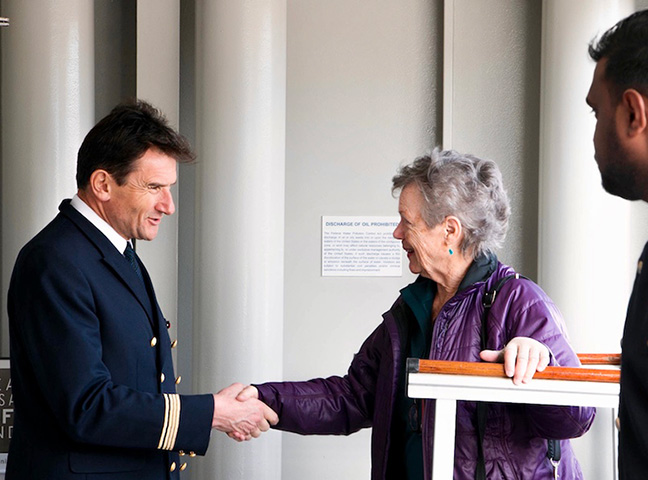
January 16–18, 2020 | Ushuaia, Argentina
We journeyed to beautiful and vibrant Argentina, and at last, the adventure had begun. After an early-morning flight from Buenos Aires to the scenic port city of Ushuaia, we eagerly boarded the elegant ‘Le Lyrial’ for our luxury Antarctica cruise, our home away from home for the next two weeks and one of the most comfortable ships on the seas today. We enjoyed the opportunity to unwind before gathering in the lounge for a glass of Champagne or taking in the sweeping views of the Beagle Channel from our staterooms.
In the evening, the A&K Expedition Team hosted a Welcome Aboard Cocktail Party, where we heard from Expedition Leader Dr. Marco Favero, Cruise Director Paul Carter and Expedition Director Suzana Machado D’Oliveira. We also heard from Stephen C. White, Glenn Gordenier and Alexander D. Bulazel from the Mystic Seaport Museum, who recognized the bicentennial anniversary of Nathaniel Palmer’s discoveries on and around Antarctica.
Following an overview of what to expect on board, the A&K Expedition Team took the stage to introduce themselves. Among them were university professors, climate researchers, ornithologists and British Antarctic Survey veterans. Knowledgeable and diverse, the team is backed by more than a hundred seasons of cumulative experience in the polar regions. Dinner was served, and after our delicious meal, we watched the misty fjords of South America fade toward the horizon. From the deck, we enjoyed our first wildlife views of albatrosses, blue-eyed shags and giant petrels filling the sky.
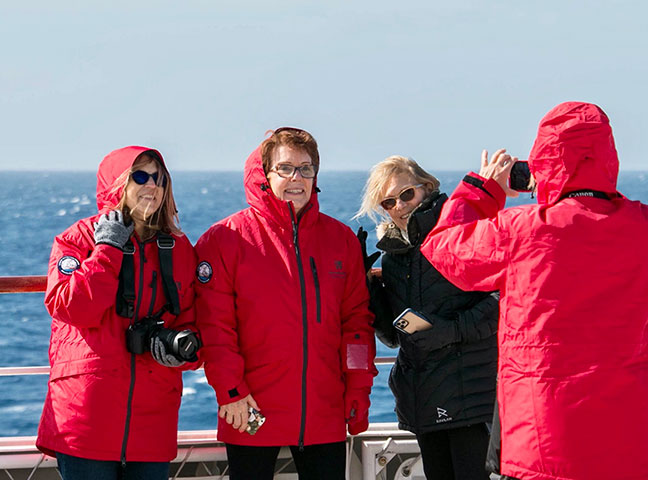
January 19, 2020 | At Sea
‘Le Lyrial’ cruised swiftly from the tip of South America toward the Antarctic Peninsula. With light winds and blue skies, a variety of seabirds visited the ship as we sailed south. Black-browed albatrosses, blue petrels and southern giant petrels shadowed us as they rode the slipstream of the ship.
Later, we heard from some of our expert guides. History lecturer Bob Burton, a particularly storied individual who has been involved in many years of Antarctic research, began with a topical lecture on early Antarctic explorers. Next, marine mammal lecturer Larry Hobbs gave a much-anticipated talk on the marine mammals of the Southern Ocean. Everyone was excited to search for whales during our time in Antarctica, and Larry offered insight into the variety of species we may encounter. Once we were closer to the peninsula, we scanned the waters for humpback whales and orcas. Farther offshore, there was even the possibility of glimpsing fin, blue, sperm and right whales. We kept our eyes peeled for these magnificent creatures, which are only beginning to make a recovery from several centuries of intense whaling.
After lunch, we continued our lecture series with history lecturer Richard Wolak, who provided a detailed synopsis of Russian naval officer, cartographer and explorer Fabian Gottlieb von Bellingshausen, who was likely the first person to ever set eyes on Antarctica. Bellingshausen is famous for his interaction with Palmer, the “hero” of our expedition. Allegedly, these two explorers met just west of the Antarctic Peninsula and compared voyage information. However, there is still some debate over the specific details or whether the event ever took place to begin with.
Next, we heard from photo coach Richard Harker, who briefed us on photography as it relates to the continent. Richard has spent many seasons photographing in Antarctica and shared a few tips and tricks with our group.
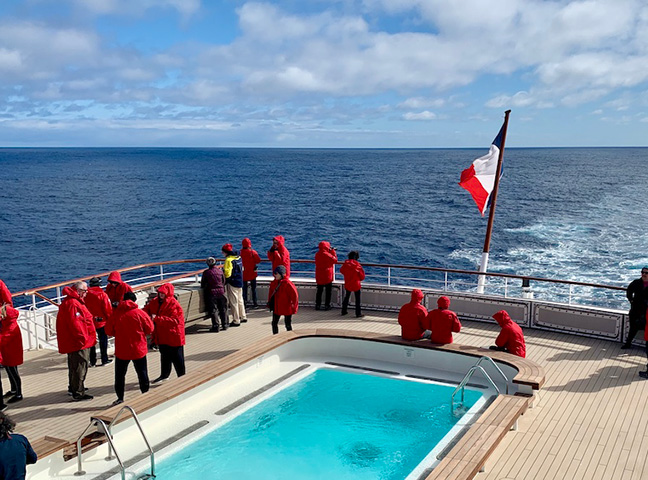
January 20, 2020 | At Sea
We awoke to smooth seas as ‘Le Lyrial’ steamed south through the Drake Passage. During the evening, we had crossed the polar front, an ecological boundary that divides Antarctica from the milder sub-Antarctic climate. It certainly showed; it was noticeably colder than it had been the last several days.
Ornithology lecturer Dr. Maria Patricia Silva Rodriguez led our next lecture. She presented an overview of the many penguin species in the world and highlighted the specific penguins we hoped to encounter. Later that morning, we also participated in a mandatory IAATO briefing, the regulatory body that oversees Antarctic tourism. We learned how to behave in such an extremely sensitive environment and what we could expect ashore and in the Zodiacs — sturdy rubber boats ideal for exploring the continent.
In the afternoon, Bob took the stage to deliver a fascinating lecture on English explorers Edward Bransfield and William Smith. Both were early explorers in the Antarctic Peninsula, and Smith was the first documented person to have stepped foot on what is now considered the Antarctic mainland. Glenn followed Bob’s talk with one of his own, where we learned more about Palmer himself — his life, his hometown of Stonington, and the triumphs and travails of his career. The presentation rounded out this historical figure as a living, breathing person, and we learned more about what made him tick.
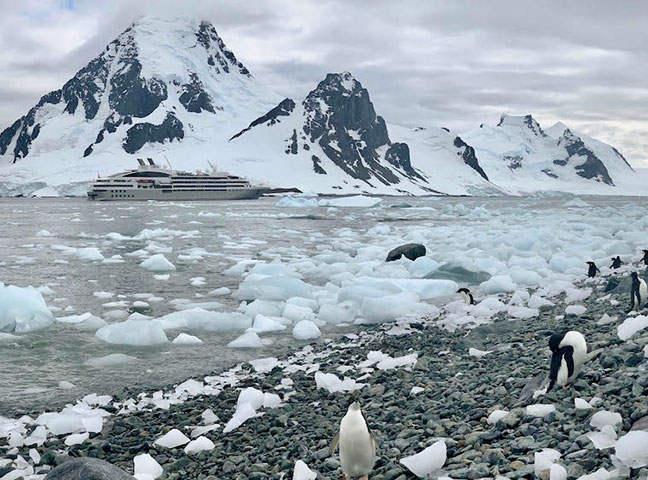
January 21, 2020 | At Sea
Looking out our cabin windows, we could see the breathtaking scenery of the Antarctic Peninsula, where glacier-capped mountains and rocky shorelines loomed around us. We watched in awe as our first icebergs came into view, and we eagerly anticipated our first morning ashore at Pourquoi Pas Island.
After breakfast, our Zodiacs deposited us on a small spit known as Bongrain Point. Hundreds of Adélie penguins — a small, brush-tailed penguin — made their home here among the island’s rocky mountains, and overhead, skuas and kelp gulls soared between their nests and the sea. In the afternoon, ‘Le Lyrial’ repositioned farther north, and we found ourselves amid ice and scenic, glacier-clad mountains in a narrow pass known as the Gullet.
We boarded the Zodiacs, this time for an hour-long cruise among ice and a variety of seals. We learned that glacial ice is freshwater ice formed as snow and deposited on land, while sea ice is formed as the ocean itself reaches its freezing point and ices over. From our Zodiacs, we spotted crabeater, Weddell and leopard seals, some of them floating together on the same iceberg. A few Adélies made an appearance too, and a humpback whale made a close approach to a few of the Zodiacs. It was a wonderful variety of Antarctic wildlife, and we returned to the ship ready for our evening recap and an early rest.
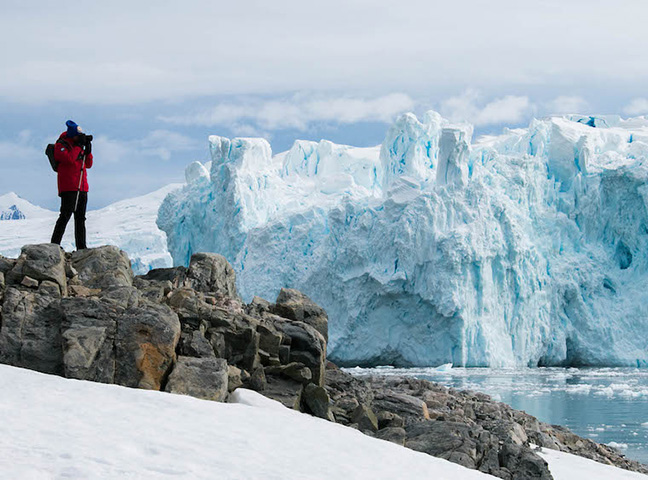
January 22, 2020 | Stonington Island & Jenny Island
We arrived at our southernmost landing on Stonington Island. This is a particularly exciting stop for our history-minded contingent aboard, for Stonington is named after Palmer’s home port. Palmer’s expedition may well have come past remote Stonington Harbor in search of seals. Today, Stonington is the site of two historic bases — one British and the other American. At the American base, we entered the old storehouse building. Here, Richard Wolak shed light on a collection of artifacts and introduced us to the Ronne Antarctic Research Expedition, which spent two winters at this site. We also learned that the first two American women to overwinter in Antarctica spent their time at this base.
British Base E was located just a few hundred feet away. Larger and more substantial, the more recently used base showed signs of its previous inhabitants, who lodged here until the 1970s. Inside, the storehouse and kitchen were still stocked with food, and the library and bunkhouse were intact. We imagined what life at a research station was like in this early period of year-round Antarctic research.
In the afternoon, ‘Le Lyrial’ repositioned to Jenny Island, a small mountainous rock that juts out of the northern section of Marguerite Bay. On the beach, several dozen elephant seals allowed us to get close, and we observed them sloughing their skin, a practice they engage in following the breeding season. This allows seals to replace their entire outer layer of skin and rid their bodies of toxins in order to maintain a waterproof, UV-resistant coating of fur. Despite some challenging weather conditions, our Zodiac drivers transported us to and from the shore safe, sound and dry. We returned to the ship at the end of the day, ready for a long rest after a day filled with adventure.
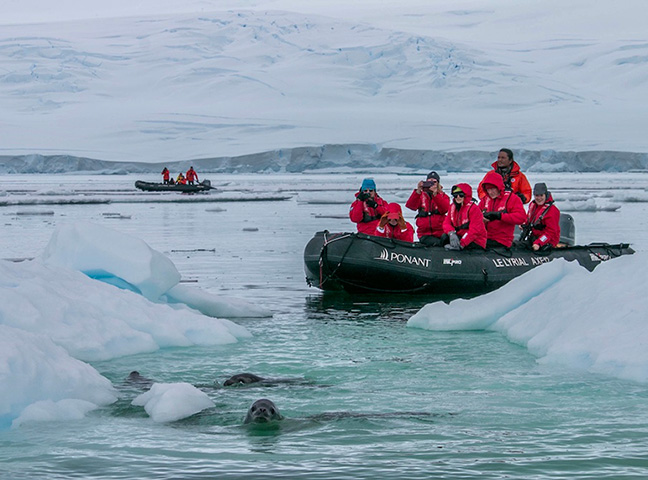
January 23, 2020 | Crystal Sound
This morning, we awoke to Antarctica at its most brooding and dramatic. Mist rolled overhead, and the dark peaks of the Antarctic Peninsula were shrouded by low clouds. We found ourselves anchored just off the coast of Detaille Island, where we boarded Zodiacs for further exploration. The remains of British Base W were present, perched tenuously on a tiny basalt rock. Green veins of olivine, incuding peridot, were visible along the shoreline. We had over an hour to explore the coast, where we hoped to find seals, penguins and sculptural icebergs.
‘Le Lyrial’ repositioned south to Lallemand Fjord in the afternoon, where thick bands of sea ice were visible on the horizon. There were many crabeater seals scattered throughout the fjord; some hauled out on ice floes while others swam in small groups in the water.
It wasn’t long before the Zodiacs were lowered into the water, and our group enjoyed a spectacular cruise amid a wonderland of ice. Many more crabeater seals were visible on vast tracts of sea ice that had yet to melt from last year. We enjoyed close-up views of the seals, some playing directly beneath our rafts.
Probably the highlight for those in the first group was the presence of a single emperor penguin. These incredibly rare birds are almost never found so far from the dense sea ice, and typically only the young birds — who have strayed far from their home colonies — are visible this far north on the peninsula. It was amazing to get close to some of Antarctica’s most iconic wildlife, and we returned to the ship glowing with excitement.
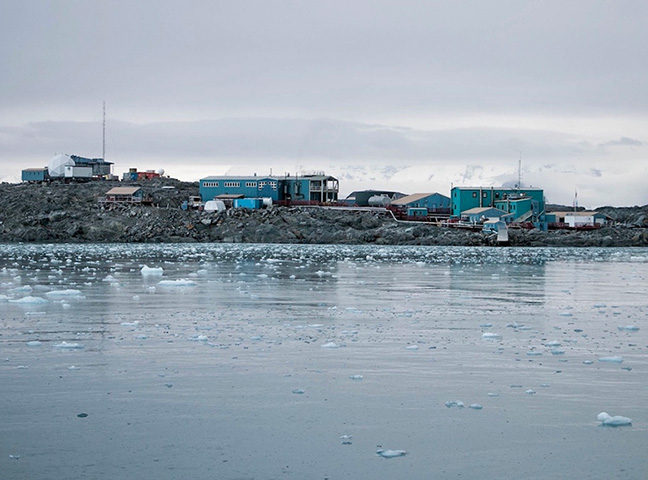
January 24, 2020 | At Sea
We arrived at Palmer Station after a leisurely morning cruising north from Crystal Sound. Soon, the station manager boarded the ship, along with a team of scientists and support staff, to deliver a presentation. We learned that Palmer Station is supported by the United States Antarctic Program, a branch of the National Science Foundation, and is one of the three U.S. research bases on the continent. It’s the site of a dazzling array of scientific studies, from long-term ecological monitoring to humpback whale photogrammetry studies and Adélie penguin health assessments.
Abercrombie & Kent Philanthropy — along with climate ecology lecturer Dr. Jim McClintock, a world-renowned scientist and longtime member of the Palmer Station team — has raised money for a set of tags to help the ornithologists here with their research. These tags will record information on birds’ location, temperature and the depths at which they are feeding — data that will be critical for understanding how a changing climate will impact the lives of Antarctic birds.
After lunch, we boarded the Zodiacs and went ashore at Palmer Station, where we were welcomed by a local staff member and given a tour of the station. Our group was taken around the building’s perimeter, and our guides identified the living quarters, generator stations, laboratories and carpentry shops that help the station function as a nearly independent entity. Palmer Station is supplied by ‘Laurence M. Gould,’ a U.S. icebreaker that services the station regularly throughout the summer and winter months.
Next, we joined the scientists and staff in the lounge for coffee and brownies. Only a few ships a year are called to the station, and we thoroughly enjoyed meeting the men and women who were helping to make a meaningful difference in the world through their contributions to polar research.
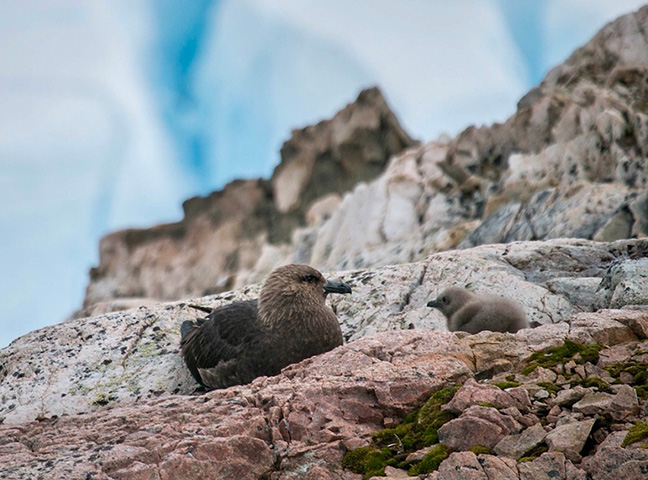
January 25, 2020 | Neko Harbour
We began our day in the scenic Errera Channel. Humpback whales spouted in the distance as our Zodiac drivers navigated around icebergs to drop us off on Cuverville Island. Here, hundreds of gentoo penguins nested among the rocky and moss-strewn outcrops. In the middle of summer, parents race to take care of their chicks, which must be fully fledged before winter arrives in just a few short months. Skuas circled overhead obsessively, hunting for a meal. During our visit, a few gentoo hatchlings were lost to these predators, who have chicks of their own to feed.
In the afternoon, we landed at Neko Harbour, our first landing on the actual Antarctic continent. Here, gentoo penguins nested on the rocky ledges overlooking a magical scene of icebergs, glaciers and mountains. These penguins, like those at Cuverville, sat on their nests while babysitting their chicks. Some scurried about, ambling to and from the colony. We also hiked to a stunning overlook on Andvord Bay, where we gazed upon our ship and marveled at the beautiful scenery beyond.
At last, we reboarded ‘Le Lyrial’ in the evening, flanked by icebergs beneath the spectacular vista of Anvers Island.
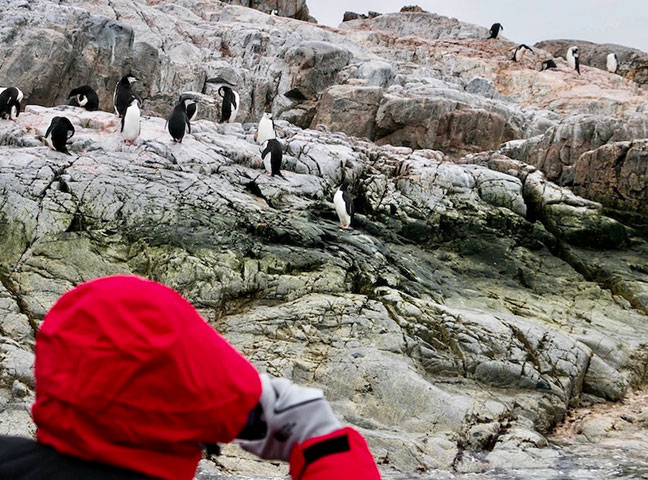
January 26, 2020 | Cierva Cove
We made our landing on a spit of bare rock known as Portal Point, where the foundation of a small hut could be seen. For a short time, the famous British polar explorer Wally Herbert called this hut home.
The hut has since been moved to Stanley in the Falkland Islands, where it lives in a museum to this day. Several Weddell seals and a lone fur seal were busy molting. One Weddell seal in particular was quite comfortable around us and came so close that we could see the markings on its coat.
We found ourselves at Cierva Cove in the afternoon, farther north along the Antarctic Peninsula. The low-lying islands and abundant wildlife provided the perfect opportunity to explore the area in our Zodiacs. Our drivers and naturalists expertly navigated thick swatches of ice to treat us to some impressive wildlife displays.
Chinstrap penguins, another species of brush-tailed penguin, darted past us on their way to and from a nearby colony. Luminous blue icebergs drifted by, some providing a platform for leopard seals taking a break from foraging. A few of us sighted a pod of humpback whales — a spectacular finale to our day.
Not long after, ‘Le Lyrial’ headed north to the magical South Shetland Islands.
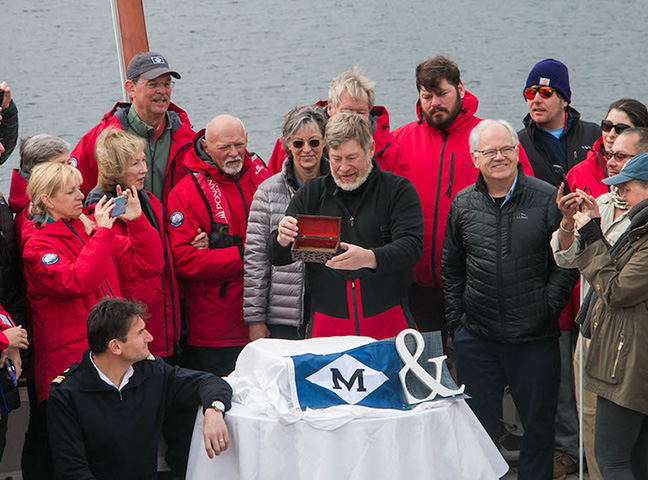
January 27, 2020 | South Shetland Islands
Our group awoke early to watch the ship’s approach to Deception Island, which maintains a protected harbor perfectly suited for ships looking to escape the Southern Ocean’s harsh weather. While glacially covered and appearing mountainous, it is actually shaped like a doughnut with a bite taken out of it.
Palmer himself was credited with discovering this harbor, which would go on to become one of the most important whaling stations on the continent. As we made our way ashore, relics from the whaling age could be found, everything from large metal boilers and storage tanks to whale bones, water boats and wooden houses. Unsurprisingly, everyone was eager to explore these alien-looking artifacts from a bygone era. Some of us headed for an old hangar on the beach, which had an airstrip from which the first aerial surveys of the Antarctic Peninsula were launched. Others arrived at an outcrop known today as Neptune’s Window. At this dramatic cutout from the island’s flank, you can look directly south toward the Antarctic mainland. According to legend, this is where Palmer had his first look of the continent on a sunny, fogless day.
We returned to the ship for a special presentation from Alex, who brought from the museum collection a piece of history: Palmer’s personal ditty box. These small boxes were carried by sailors, who would keep mementos during their time at sea. Palmer’s box, beautifully inscribed with floral motifs and lined with rich red wool, is one of only two items that remain from his famous expedition aboard ‘Hero.’ The other item, the voyage log, is kept in the National Archives and Records Administration. This box is now the oldest surviving artifact to return to Antarctica, two centuries after ‘Hero’s’ visit to the White Continent. Alex was thrilled to show us this artifact up close, and we appreciated the historical significance of the moment with our new friends from the museum.
In the afternoon, we made our way ashore for our final taste of the South Shetland Islands. We could hear the howling of the wind and waves, but our expert Zodiac drivers still managed to provide relatively comfortable passage to Yankee Harbour, a small, circular port protected from the oceans beyond by a thin strip of gravel beach.
The “beach” was in fact a glacial moraine, an accumulation of debris deposited by a glacier. A few artifacts also dotted the beach, among them an old try-pot — a large iron cauldron used for reducing blubber to oil — which could be seen along the rocky storm berm that stretched into the ocean.
We also saw more gentoos and chinstraps and learned about the fascinating volcanic geology of the South Shetland Islands. We took our last look at the Antarctic region, where we reflected on our amazing time spent here. Then, we hopped aboard the Zodiacs and headed back to the ship.
Tonight, the mysterious Antarctic quietly slipped beneath the horizon, and we began to feel the gentle rolling of the ship as ‘Le Lyrial’ steamed north.
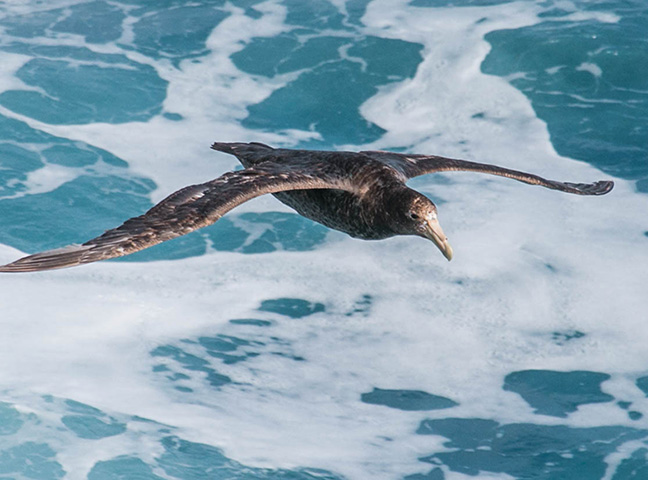
January 28, 2020 | At Sea
‘Le Lyrial’ pushed quietly through the swell of the Drake Passage. As we sailed north, our lecture series continued. Geology lecturer Dr. Jason F. Hicks presented a comprehensive overview of the dynamic world of ice. We can retrieve a tremendous amount of data from ice cores taken throughout the Antarctic and Greenland icecaps, and Jason revealed the millions of data points that have more or less recorded humanity’s carbon footprint throughout the past few hundred years.
We heard from Jim next, who shed light on the fascinating world of drug discovery in Antarctica. The many invertebrates that live in these waters rely on chemical processes that have medicinal applications. A highlight for many, his talk opened our eyes to the fascinating confluence of medical and ecological sciences.
In the afternoon, Richard Harker kicked off our lecture series, teaching us the basics of photo post-processing and how to handle our images the way some of the great early photographers would have. Using landscape photographer Ansel Adams as an example, Richard revealed how we could develop a workflow in the digital age that would allow us to create truly stunning works of art.
At last, we heard from Richard Wolak, who offered a captivating retelling of his time overwintering on an Antarctic base. Very few people have spent a winter in Antarctica, and Richard’s story of his experiences at the Amundsen-Scott South Pole Station in the 1970s was an absolute delight.
In the evening, Captain Marchesseau invited everyone to join him once more in the theater for the Farewell Cocktail Party. He said a few touching words regarding our time at sea, and afterward, we expressed our gratitude toward the entire staff for making our voyage so safe and comfortable.
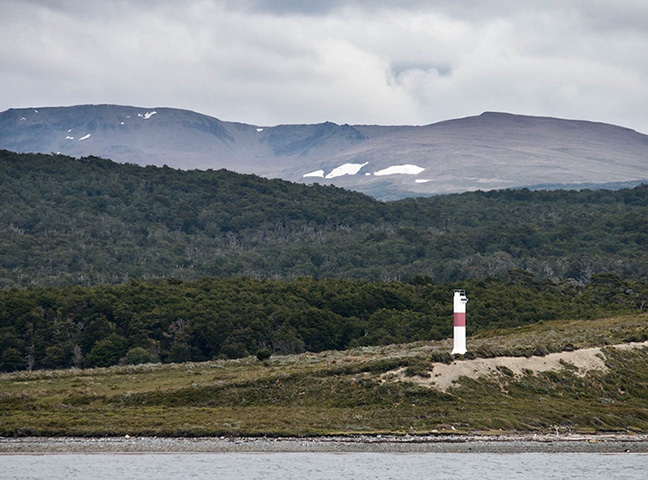
January 29, 2020 | Ushuaia, Argentina
‘Le Lyrial’ swiftly approached the southern tip of South America, and our journey at last came full circle. In the morning, Paul and Assistant Cruise Director Sally Escanilla hosted a disembarkation briefing as we made our way home. Alongside the rest of the A&K Expedition Team, they also took care of all our departure arrangements.
Early in the afternoon, Larry offered a sobering talk on sustainability. Human activity over the last few centuries has catapulted us far beyond what the planet and its resources can sustain, and his talk brought to light the challenges we face today, from overpopulation to our reliance on fossil fuels and the steps we can take toward overcoming them.
All scientific and empirical evidence points to the fact that a dramatic paradigm shift is necessary to avoid economic, environmental and social collapse over the next century. Later on, we gathered one last time in the theater for our final recap. After some closing comments from the team, we watched a motion-picture slide show that had been shot and edited by naturalist and Zodiac driver Richard “Blackjack” Escanilla, who also happens to be a talented videographer. It was an emotional retelling of our epic journey, and we were quite moved as we made our way from the theater to prepare for our arrival in Ushuaia. Soon enough, we went ashore and stretched our legs ¬— our first time on solid ground in ages — and many of us took the opportunity to enjoy some of the city’s fantastic restaurants.
January 30, 2020 | Ushuaia
Today marked the end of our incredible journey in Antarctica. As we enjoyed breakfast aboard ‘Le Lyrial,’ we reflected on the vast abundance of wildlife and scenery we had the fortune of experiencing over the past 10 days. From icy whale-rich straits and channels to the historic huts and research bases, we had covered a tremendous amount of ground and shared in an unforgettable, life-changing experience. The expedition had inspired us to go on with a stronger conservation ethic and to protect the wildlands around our home — wherever that may be.
 The Americas
The Americas Europe, Middle East and Africa
Europe, Middle East and Africa Australia, NZ and Asia
Australia, NZ and Asia






































































































































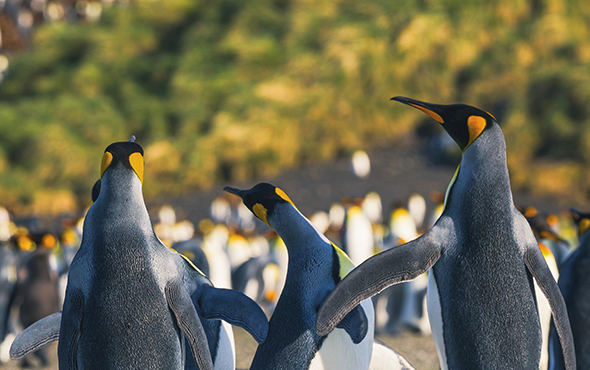
 The Americas
The Americas
 Europe, Middle East and Africa
Europe, Middle East and Africa Australia, NZ and Asia
Australia, NZ and Asia